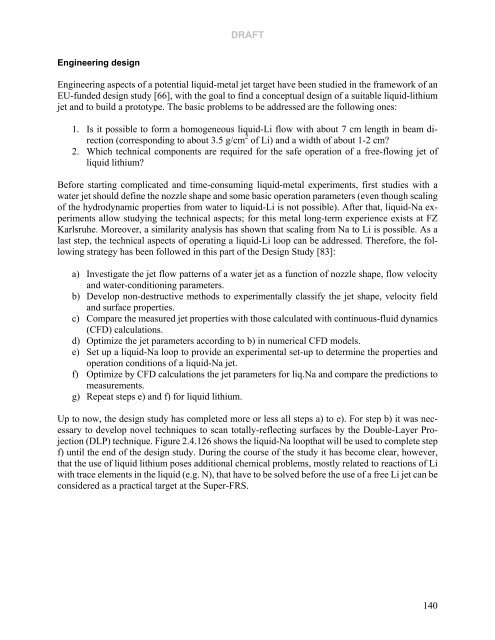Technical Design Report Super Fragment Separator
Technical Design Report Super Fragment Separator
Technical Design Report Super Fragment Separator
You also want an ePaper? Increase the reach of your titles
YUMPU automatically turns print PDFs into web optimized ePapers that Google loves.
Engineering design<br />
DRAFT<br />
Engineering aspects of a potential liquid-metal jet target have been studied in the framework of an<br />
EU-funded design study [66], with the goal to find a conceptual design of a suitable liquid-lithium<br />
jet and to build a prototype. The basic problems to be addressed are the following ones:<br />
1. Is it possible to form a homogeneous liquid-Li flow with about 7 cm length in beam direction<br />
(corresponding to about 3.5 g/cm 2 of Li) and a width of about 1-2 cm?<br />
2. Which technical components are required for the safe operation of a free-flowing jet of<br />
liquid lithium?<br />
Before starting complicated and time-consuming liquid-metal experiments, first studies with a<br />
water jet should define the nozzle shape and some basic operation parameters (even though scaling<br />
of the hydrodynamic properties from water to liquid-Li is not possible). After that, liquid-Na experiments<br />
allow studying the technical aspects; for this metal long-term experience exists at FZ<br />
Karlsruhe. Moreover, a similarity analysis has shown that scaling from Na to Li is possible. As a<br />
last step, the technical aspects of operating a liquid-Li loop can be addressed. Therefore, the following<br />
strategy has been followed in this part of the <strong>Design</strong> Study [83]:<br />
a) Investigate the jet flow patterns of a water jet as a function of nozzle shape, flow velocity<br />
and water-conditioning parameters.<br />
b) Develop non-destructive methods to experimentally classify the jet shape, velocity field<br />
and surface properties.<br />
c) Compare the measured jet properties with those calculated with continuous-fluid dynamics<br />
(CFD) calculations.<br />
d) Optimize the jet parameters according to b) in numerical CFD models.<br />
e) Set up a liquid-Na loop to provide an experimental set-up to determine the properties and<br />
operation conditions of a liquid-Na jet.<br />
f) Optimize by CFD calculations the jet parameters for liq.Na and compare the predictions to<br />
measurements.<br />
g) Repeat steps e) and f) for liquid lithium.<br />
Up to now, the design study has completed more or less all steps a) to e). For step b) it was necessary<br />
to develop novel techniques to scan totally-reflecting surfaces by the Double-Layer Projection<br />
(DLP) technique. Figure 2.4.126 shows the liquid-Na loopthat will be used to complete step<br />
f) until the end of the design study. During the course of the study it has become clear, however,<br />
that the use of liquid lithium poses additional chemical problems, mostly related to reactions of Li<br />
with trace elements in the liquid (e.g. N), that have to be solved before the use of a free Li jet can be<br />
considered as a practical target at the <strong>Super</strong>-FRS.<br />
140















